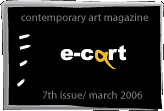Suzana Milevska
NAMING AND URGENCY
Hristina Ivanoska Naming of the Bridge "Rosa Plaveva and Nakie
Bajrami"
Hristina Ivanoska's project Naming of the Bridge "Rosa Plaveva
and Nakie Bajrami" deals with the question of the veil and the
first women protestors against the veil in Macedonia: the Macedonian
Rosa Plaveva and the Turk Nakie Bajrami. She had come to her idea for
this project in 2004, during our conversation when I mentioned some
details from my research, and after reading in the local newspapers
an open call for submission of proposals for naming the new bridge that
was to be built between the south and north bank of the Vardar river
in the centre of Skopje.
Since then Ivanoska engaged in an on-going research project officially
lunched on 28 April 2005, when she submitted her official proposal to
the Committee for Naming Streets, Squares, Bridges and Other Infrastructure
Objects.
In this document, handed over to the Council of the City of Skopje office
in charge of public initiatives, Ivanoska states her proposal to name
the newly built bridge after the two women who (according to several
texts by the Macedonian historian Vera Vangeli), protested against the
veil and were imprisoned together in Skopje in 1908.
I found relevant this project for my own research of archive of veils/events.
Taking into account that the Skopje river Vardar passes through the
city dividing it in two parts, one mostly Macedonian (Orthodox-Christian),
the other predominantly inhabited by Muslims (mostly Albanians and some
Turks), Ivanoska's concept is very clearly pointing to the urgent need
to re-establish the silenced communication between these two strictly
divided city parts. Since the conflicts between the Albanian ethnic
minority troops and the Macedonian Army in 2001, the trust between the
two previously cooperating communities has been further shaken.
Moreover, in the Balkans, the issue of the veil is still not discussed
openly and its urgency is not very clear to the authorities dealing
with the issues stemming out the multicultural environment. Many regulations
still have to be adjusted to the recent re-actualisation of the veil.
Until recently, before the Balkan countries started the application
process to enter the European Union, the question was completely neglected
and treated in a way comparable to how it was treated during the communist
period: the authorities could still get away with unwritten practices
or restrictive laws being voted without discussions in the public realm.
In these terms, Ivanoska's project is still a rare example of individual
initiative for looking at this issue with sensitivity that would not
be burdened only by the conflicts from the past but looking for some
positive examples. Instead, it offers an appreciation towards culturally
different gender difference and an attempt to build a bridge between
the different stances towards the veil in conflicting intellectual and
cultural camps.
The persistent issue of the veil is related to the image of a veiled
woman that has been used as a frequent metaphor for unveiling/revealing
the truth. The conception of truth as a veiled woman has a long tradition
in Western philosophy, mainly based on the understanding of East/Asia
as a woman, a veiled, mysterious, irrational, sensitive, and exotic
woman that is inaccessible to 'Western men'. However, once a trope,
a metaphor used by philosophers and poets to relate women to truth,
the veil today is much more than an object/garment of Oriental origin.
It becomes an urgent political, social, and legal question. With the
extensive movements of populations and the increase in migration, the
result has been a mixing of different cultural codes. The question of
the veil became one of the most relevant issues in multicultural and
multiethnic societies such as the Balkans. Old rules and laws have been
called into question; the schools regulations began to change and individual
cases ended in courts sparking everyday debates pro and against the
veil becoming lucrative media news.
In my research, the discussion of this urgent issue was not initiated
only by the fact that the veil acquired a cultural and media status.
I was in fact first intrigued by a single photograph of an unveiled
young Albanian girl, taken in the photographic studio of the Brothers
Manaki in Bitola, Macedonia (between 1905-1916) and the strange coincidence
that the first demonstration against the veil took place in Macedonia
almost at the same time (1908).
In fact, this coincidence is most probably a result of the Young Turks'
Revolution that actually started in the Balkan provinces of the Ottoman
Empire at the same time - in 1908. The later speeches of the "father"
of contemporary Turkish nation Kemal Ataturk against the veil came as
a result of his European upbringing and education in the Military School
in Bitola and his participation in Young Turks' conspiracy exactly during
the period when Brothers Manaki took the photograph of the unveiled
girl. The fact that almost one hundred years later, the question of
the veil retains the same relevance for contemporary cultural, religious,
and gender debates in the Balkans and elsewhere added to my interest
in this unique garment.
In the attempt to address the persistence of the veil and the ways in
which this issue marks cultural, religious and gender difference in
many cultures Hristina Ivanoska performs her proposal for naming the
bridge as a kind of agency for a change in the public sphere. The fact
that the names of these two female heroes have been long forgotten is
not an accident. Women are still rarely present in the public life in
the Balkans. Even though during the fifty years of communist regime
women gained many rights that facilitate their public presence, the
transition period revealed the weakness of and superficiality of the
gender equality and brought to light many contradictions in gender relations.
Paradoxically, on the way to democracy and as part of complex negotiations
with European authorities to adjust the laws with the laws of European
Union, women had more to lose than men.
In 2001, Ivanoska worked on a project that also dealt with the public
presence of women. She made an art work involving research into the
number of streets and boulevards that carry names of famous women -
heroes, intellectuals or public personalities. Her research showed discouraging
results and underlined even more the fact that the equality of women
during communism was partial. Namely, her research showed that only
24 streets out of 1078 officially named streets in Skopje turned out
to have been named after women or events in women's history, and none
of the names of the boulevards included female names.
Her project actually consisted of a metal plate that Ivansoka created
according to the established and official standards for such signs,
with her own name and nick-name written on it. Thus, she imagined and
named a virtual boulevard referring to the lack of presence of the names
and other information recording important personalities and events in
lives of women in the public spaces in Skopje.
 |
|
|
||||||||||||||||||||
 |
 |
 |
|
|||||||||||||||||||
| |
|
|||||||||||||||||||||
 |
|
 |
|
|||||||||||||||||||
 |
|
|||||||||||||||||||||
| |
|
|||||||||||||||||||||
 |
 |
|
|
|||||||||||||||||||
 |
 |
|
|
|||||||||||||||||||
| |
 |
|
|
|||||||||||||||||||
 |
|
|||||||||||||||||||||
 |
|
|||||||||||||||||||||
 |
|
|
|
|||||||||||||||||||
| |
|
|
|
 |
|
|||||||||||||||||
| |
|
|||||||||||||||||||||
| |
|
|||||||||||||||||||||
| |
|
|
||||||||||||||||||||
 |
|
|||||||||||||||||||||
 |
 |
|
|
|||||||||||||||||||
| |
 |
|
|
|||||||||||||||||||
 |
|
|||||||||||||||||||||
 |
|
|||||||||||||||||||||
 |
|
|||||||||||||||||||||
| |
|
|
|
|
|
|
|
|
|
|
|
|
|
|
|
|
|
|
|
|
|
|